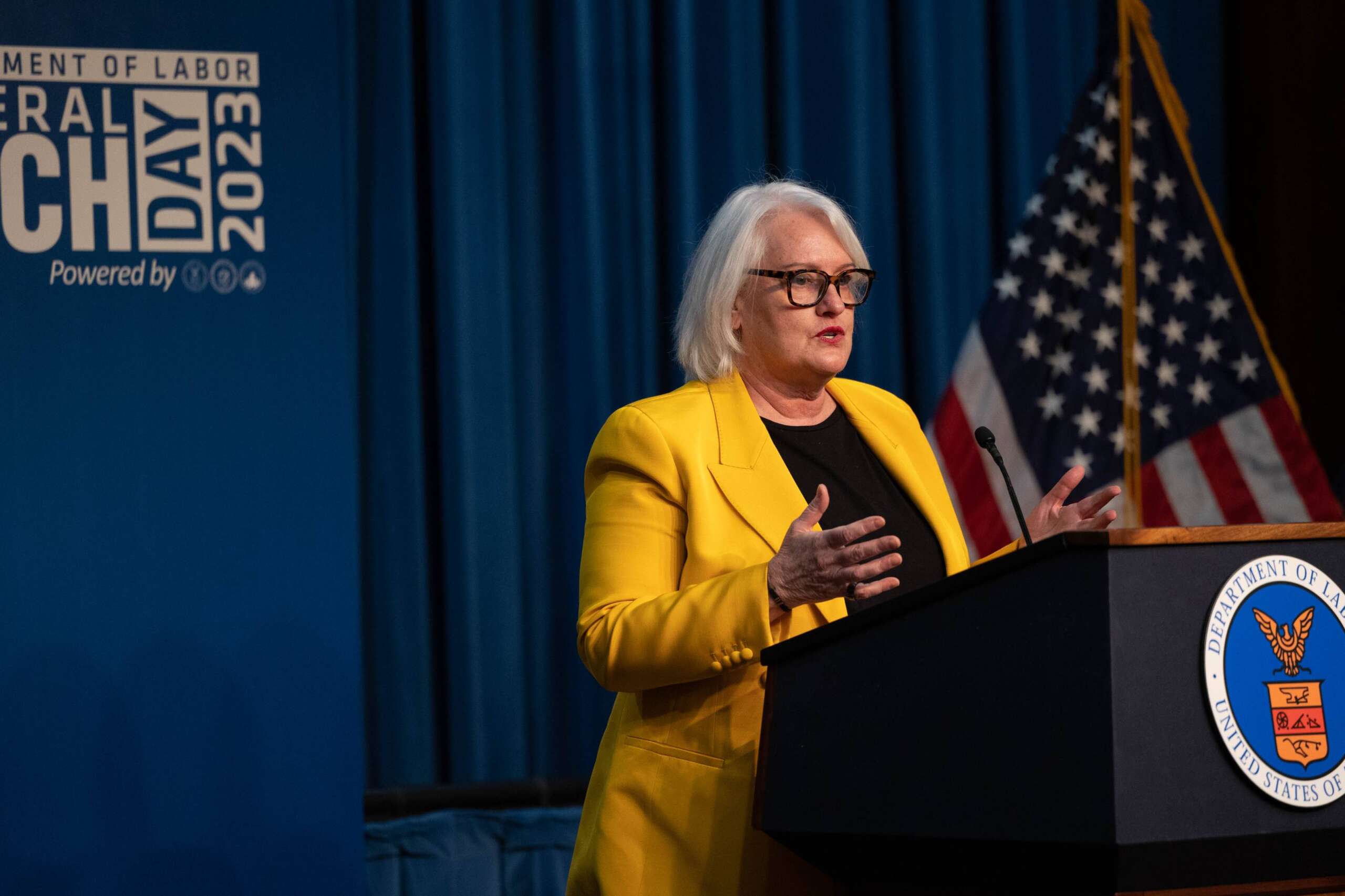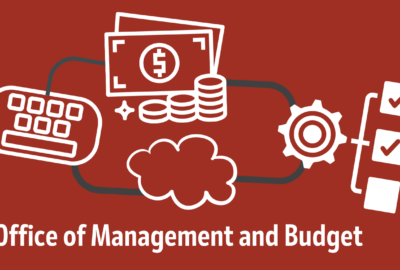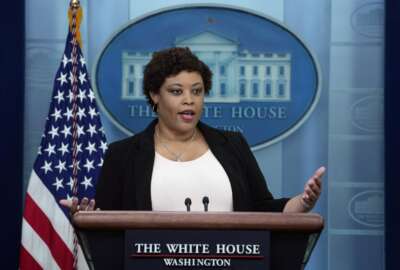Exclusive
Federal CIO Martorana’s top 3 priorities for 2024
Clare Martorana, the federal chief information officer, said the Technology Modernization Fund invested more than $177 million in 18 projects in 2023.
Since September, the Office of Management and Budget has been working in policy overdrive. Six draft or final memos came from OMB’s Office of the Federal Chief Information Officer.
On Sept. 23, OMB issued the long-awaited digital services memo to implement the 21st Century IDEA Act.
About a month later, OMB offered draft updates to the cloud security initiative called Federal Risk Authorization and Management Program (FedRAMP) for the first time since 2011.
A week after that, the draft guidance for implementing the executive order on artificial intelligence detailed a host of new requirements for agencies.
Then there is the annual Federal Information Security Management Act (FISMA) guidance that dropped in early December with a specific focus on operational technology and internet of things devices.
And finally, OMB offered an early Christmas present in the form of the new requirements to ensure agencies are meeting the accessibility standards under Section 508.
Hopefully, the OMB staff took a breadth and some time off after that sprint.
Two months into calendar year 2024, OMB is revving back up to finalize many of these policies.
Federal News Network checked in with Federal CIO Clare Martorana to see what stood out to her in 2023 and what her priorities are for 2024. The following email conversation is edited only for style and clarity.
FNN: 2023 was a busy year for the Office of the Federal CIO. What are some of your office’s efforts that may not have received as much attention or notice, but will have a big impact on federal IT sector in the years to come?
Martorana: Above all else, our north star is delivering for the American people. We need to ensure that Americans’ experience with government matches the quality and experience of the private sector — and I think we have made great progress on this.

One of the things I’m most proud of is the work we’ve done in partnership with other federal offices — that’s how we can make a big lasting impact on federal IT, which benefits how Americans interact with government. For example, the Executive Order on Improving the Nation’s Cybersecurity was released early in the administration and it called for a transformation of federal cybersecurity, based on universal adoption of strong authentication, encryption and zero trust principles across the government. As a result of the efforts of my office, our partners at the Office of National Cyber Director and the Cybersecurity and Infrastructure Security Agency (CISA), we are seeing significant cultural and technological change across the federal enterprise to strengthen our cybersecurity posture.
We also partnered with CISA on CyberStat, a holistic program which strengthens agency defenses by addressing individual agency challenges, reducing the potential for successful attacks, and bringing risks to the attention of executive leadership when necessary, all while maximizing limited OMB and CISA resources. With over 6,000 attendees across 16 engagements in 2023, we provided agencies with the information and tools necessary to achieve specific security outcomes in a more consistent manner.
My office also works closely with the General Services Administration’s Technology Modernization Fund (TMF) Program Management Office (PMO). The TMF works in complement with the appropriations process, allowing agencies to quickly access capital to tackle the IT modernization needed to keep up with the fast pace of changing technology. In fiscal 2023, the TMF invested more than $177 million in 18 projects that improve how the federal government provides services to the American people, increasing public trust and making it easier to get the services they need.
Over the past year, we worked closely with GSA Technology Transformation Service (TTS) to ensure an integrated approach to tackling our biggest IT challenges. We continue to meet with GSA leadership on a weekly basis and our teams are engaging daily to support the implementation of our policies, such as helping develop and provide agencies access to tools that will help them deliver a digital-first experience to the public.
Lastly, I want to highlight the strong connection my staff has established with our budget colleagues to ensure funding and resources are aligned so that agencies can best secure their infrastructure and be on the road to digital transformation.
FNN: Of the policies/guidance your office did issue in 2023, which ones do you think will have the biggest impact in 2024 and why?
Martorana: Building off the customer experience executive order and the President’s Management Agenda Customer Experience Priority Area, in September, we released digital experience guidance to help agencies move faster to deliver the simple, seamless, and secure experience that the American people deserve. Some 430 federal agencies and sub-agencies provide information and services to more than 400 million individuals, families, businesses, organizations and local governments each year.
Digital is increasingly becoming the primary way that the public interacts with government and accesses the information and services they depend on. In order to provide the best possible customer experience — we must fix the digital experience.
Right now, everyone is talking about artificial intelligence and the power and potential that it yields. Our pending FedRAMP guidance will significantly scale the size and scope of the FedRAMP marketplace.
Another piece of guidance issued in 2023 that is having an immediate, positive impact in 2024 is our Digital Accessibility guidance, which is based on the idea that all Americans should have equal access to government. Sixty-one million adults in the United States have a disability, an estimated 15 million or more people have a temporary disability, and an estimated 40 million people are caregivers who provide support to a person with a disability. There is nothing more heartbreaking than someone being unable to use accessible technology to complete what should be a basic task. That’s why our Digital Accessibility guidance is so important; it helps build and sustain an accessible Federal technology environment that delivers for everyone.
FNN: What are your top 3 priorities for 2024 and why?
Martorana: Strengthening Office of the Federal CIO’s foundation to enable our staff to grow and thrive. They are working on the front lines across the Federal ecosystem to drive progress and positively impact the way services are delivered to the public each and every day. And while there is a lot of external attention on our policies, there is often little discussion on the people behind the policy. As I look at 2024, I’m so excited by our team and what we will be able to achieve together.
Supporting agencies in operationalizing the policies we issued over the past few years. Every agency is at a different place on their journey — our job is to ensure they have the executive support, shared services and tech talent needed to deliver results.
Ensuring continuity so agencies and tech teams across government can continue making progress in modernizing technology. We’ve delivered and we’ve built a strong foundation of tech policies that will span from year to year and across administrations. The American people deserve good government every day. Technology is critical to delivering a government that meets today’s expectations — and we must continue moving forward.
FNN: There is a lot of excitement around artificial intelligence in the public sector, how is your office trying to balance the excitement with all the challenges that come with AI?
Martorana: AI presents tremendous opportunities to improve public services, such as making it easier to access benefits, preventing drug shortages, or fighting wildfires. While we harness AI’s power for good, we also need to protect people from its potential risks. My goal as the Federal CIO is ensure the federal government is a leader in both using AI and managing its risks. That’s why we’re issuing extensive guidance to federal agencies on their use and governance of AI, which will be finalized this spring.
In the meantime, the AI EO directed agencies to name a chief AI official (CAIO), a senior agency representative responsible for driving consistent implementation of AI practices across their agency. I recently convened and [led] the first meeting of the CAIO Council, a new executive council that will coordinate the development and management of AI across agencies. We know that innovation relies on great minds coming together to rethink what is possible. Ensuring that the U.S. is a world leader in AI will require all of us — across government, academia, civil society, and industry — to be successful.
FNN: There is a lot of excitement over the special salary rate for IT/cyber workers, but agencies are struggling to implement and fund it. How is your office, with your partners in OMB, addressing this opportunity to use the SSR to help agencies recruit and retain the best talent?
Martorana: Now more than ever, we need technologists at the table to collaborate with our nation’s leaders and provide expertise on how best to launch products and services that are secure by design, digital by default, and accessible to people of all abilities. There are many entry points to federal government and we are continually trying to reduce barriers.
Late last year, we launched a new page on CIO.gov to serve as a “front door” into government for technologists at all levels. When you navigate to CIO.gov, you will see a banner with a call to action to join us.
If you are thinking about a career in civil service, I encourage you to check it out and consider putting your tech superpowers to work for your families, friends and neighbors.
FNN: What is your message to non-technology federal IT leaders, such as those in the finance or acquisition or mission areas?
Martorana: Technology today is deeply integrated into nearly every facet of our federal operations and services. It presents both opportunities and threats that we cannot afford to overlook. All leaders — regardless of background — need to make technology a core priority. We can deliver a government that rivals our favorite consumer brands.
What it takes is a C-Suite — leaders beyond CIOs, CISOs, and chief data officers (CDOs) — it will take chief human capital officers (CHCOs), chief acquisition officers (CAOs), CFOs, general counsels and public affairs teams to align their efforts to support an agency’s technology journey map to modernize how they deliver products and services. They’ll reduce administrative burden for their workforce, improve employee engagement and inspire others to join us in the effort.
FNN: What is your message to federal IT vendors?
Martorana: Read our final guidance to understand the federal government’s requirements and our draft guidance to understand where we are heading.
Know where agencies are on their IT modernization journeys and sell them the appropriate tools, technology and solutions — meet them where they are.
Let’s collaborate: we get the best ideas when we share lessons, challenges, and opportunities for delivering faster.
Copyright © 2025 Federal News Network. All rights reserved. This website is not intended for users located within the European Economic Area.
Jason Miller is executive editor of Federal News Network and directs news coverage on the people, policy and programs of the federal government.
Follow @jmillerWFED







